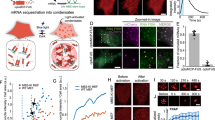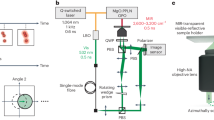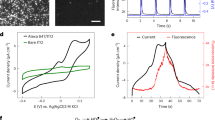Abstract
FOR a number of observations with the interference microscope on suspensions of living cells, it is desirable to be able to make the upper and lower surfaces of the cell flat and parallel without producing irreversible damage. A number of compressors are known (for example, Rousselet), but none provides quite the degree of control which is required. The compressor illustrated in Fig. 1 depends upon the bending of the slide S 2 and is therefore completely free from shear play and other uncontrollable movements, unlike compressors which depend upon sliding motion. In addition, the mounting of the cells on the small strip of glass B, which is sealed to the lower slide S 2 with ‘Araldite’, avoids any disturbances due to changes in capillary attraction. The curvature of the meniscus at M is little affected by small changes in the gap G. These two conditions enable quite reversible changes in the gap to be effected over distances of about two microns. The actual thickness of the gap can be readily measured on the microscope with the help of an air bubble as previously described1. In addition, the medium surrounding the cells can be easily exchanged in this compressor without producing capillary disturbance.
This is a preview of subscription content, access via your institution
Access options
Subscribe to this journal
Receive 51 print issues and online access
$199.00 per year
only $3.90 per issue
Buy this article
- Purchase on Springer Link
- Instant access to full article PDF
Prices may be subject to local taxes which are calculated during checkout
Similar content being viewed by others
References
Ambrose, E. J., Proc. Roy. Soc., B (in the press).
Barer, R., and Thaczyk, S., Nature, 173, 821 (1954).
Pantin, C. F. A., J. Mar. Biol. Assoc. U.K., 13, 24 (1923).
Author information
Authors and Affiliations
Rights and permissions
About this article
Cite this article
GOLDACRE, R., EASTY, D. & AMBROSE, E. A Cell Compressor for the Measurement of Mass and Concentration by Interference Microscopy. Nature 180, 1487–1488 (1957). https://doi.org/10.1038/1801487b0
Issue Date:
DOI: https://doi.org/10.1038/1801487b0
This article is cited by
Comments
By submitting a comment you agree to abide by our Terms and Community Guidelines. If you find something abusive or that does not comply with our terms or guidelines please flag it as inappropriate.



